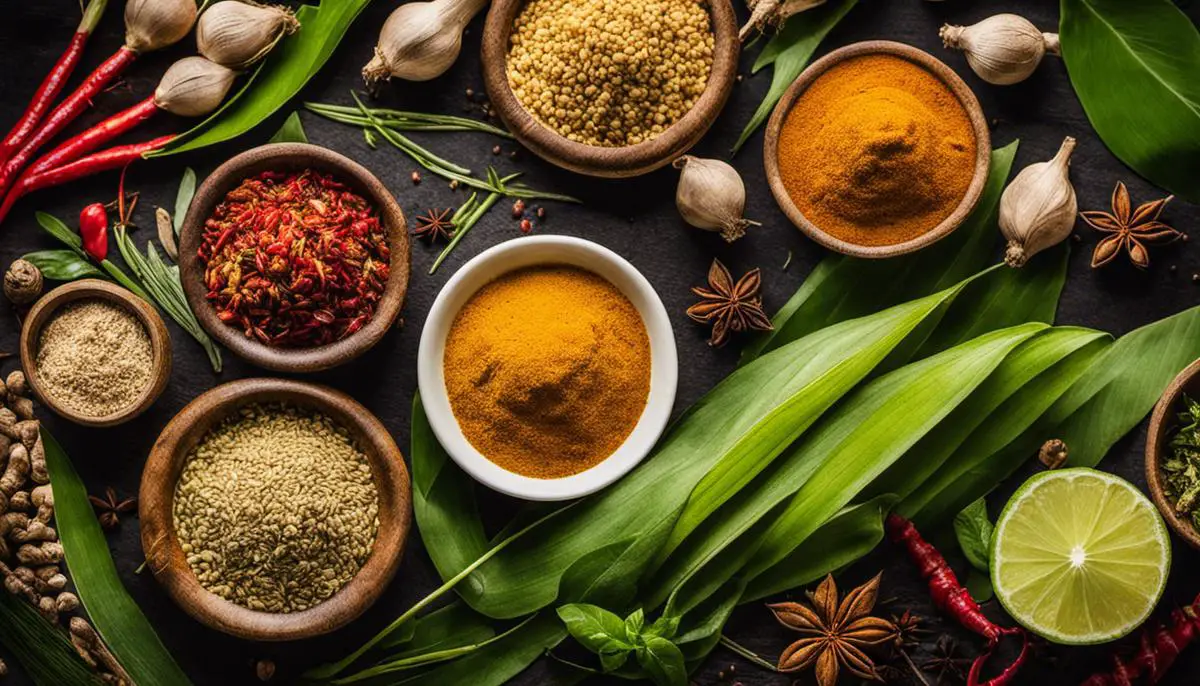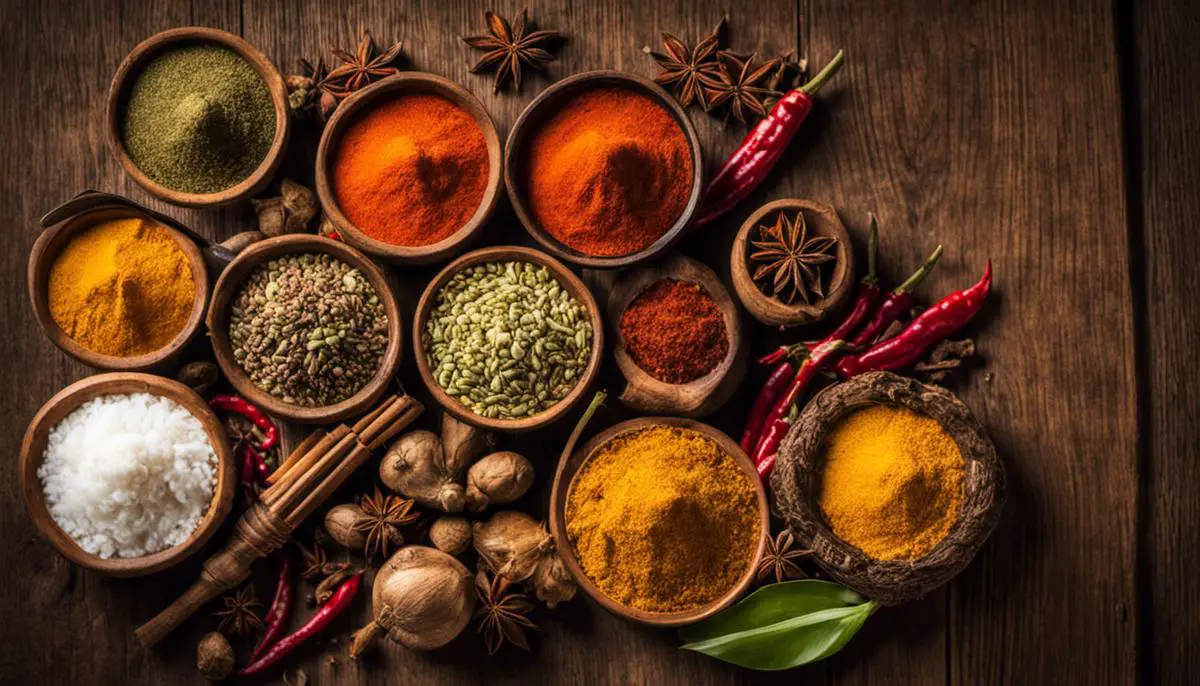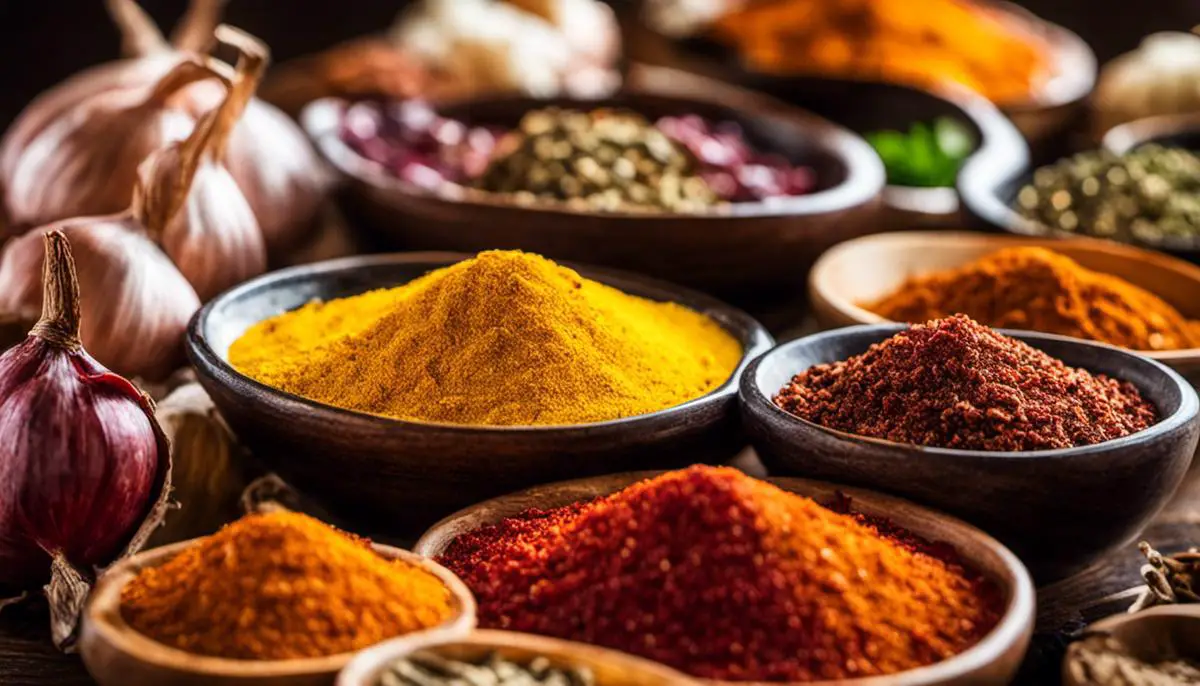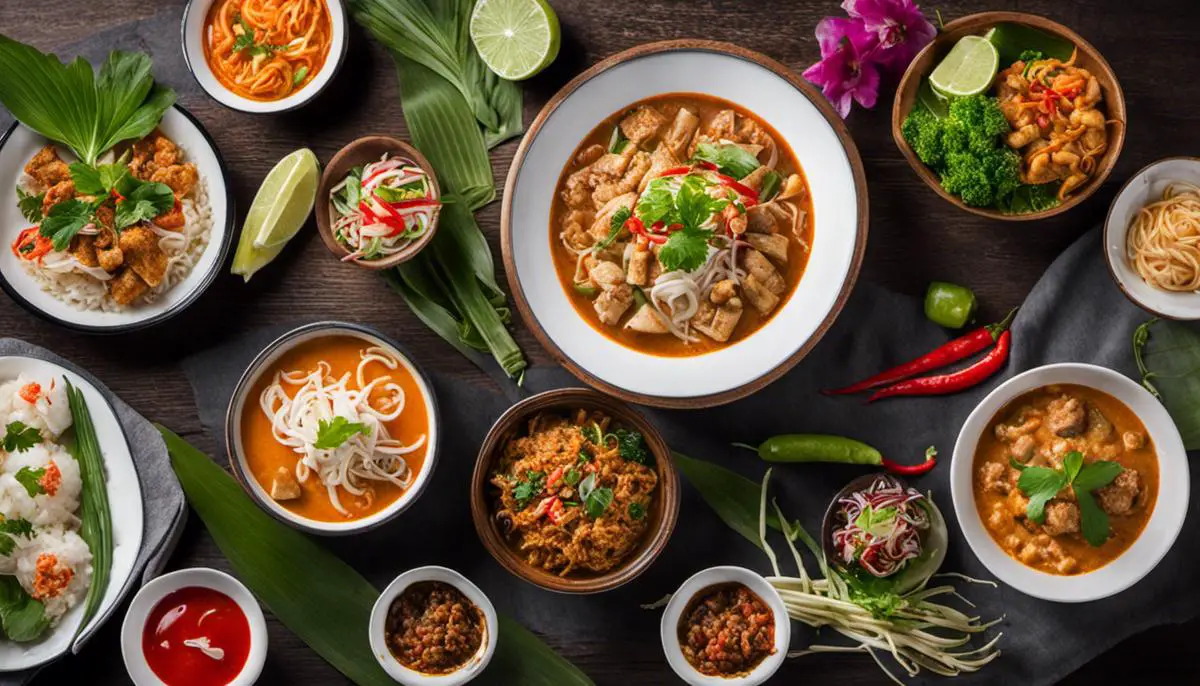
The tantalizing world of Thai cuisine offers a plethora of diverse, robust, and aromatic spices that not only titillate taste buds but also introduce a myriad of health benefits. The magic of Thai cooking lies in the way it conjures harmony within diversity, using a myriad of herbs and spices like lemongrass, Kaffir lime leaves, galangal, and Thai basil. These unique components, each with its distinct flavor profile, blend seamlessly to create a well-balanced, multi-layered taste experience that Thai food is renowned for. This exploration delves into the art of using Thai spices, their myriad health benefits, the intricacies of pairing, and practical tips for cooking.
Understanding Thai Spices
An adventure packed with vibrant cultures, radiant smiles, busy street markets, and breathtaking temples, Thailand is a true southeast Asian jewel. But one of the most outstanding takeaways from any journey to Thailand is the culinary experience! The food bursts with flavors that dance on your palate and leave an unforgettable aftertaste that lingers in your memory. At the heart of these mesmerizing flavors are the Thai spices, each unique, packing a punch, and adding an extra zing to the dishes.
Without further ado, let’s take a culinary voyage to discover some commonly used Thai spices.
Holy Basil (Kaphrao)
This spice is unlike the sweet basil you toss into your homemade marinara. Holy basil, or Kaphrao, has a sharper, peppery flavor that adds an unconventional, subtle zest to spicy dishes. A star ingredient in ‘Pad Kaphrao’, a stir-fry dish with minced pork or chicken, it’s a must-try for your Thai cooking adventures!
Chilies (Prik)
Whether fresh, dried, or ground, chilies sit at the center stage of Thai cuisine. ‘Prik’, as they are locally known, adds to the signature bite that makes Thai foods so invigorating and unique. You’ll find them in everything from curries to Thai salads and savory sauces.
Galangal (Kha)
Slightly peppery and sweet, Galangal, also known as Kha, is widely used in Thai salads and soups. It may look like ginger, but don’t get fooled by its aroma that carries a hint of citrus and has a fantastic ability to instantly elevate any dish.
Lemongrass (Ta-khrai)
Picture a lemony, herbal, earthy scent wafting through the air. That aroma belongs to lemongrass, or Ta-khrai, a notable Thai spice used in soups like the popular ‘Tom Yum’, curries, and even Thai beverages.
Kaffir Lime Leaves (bai-makrut)
This is a go-to spice for adding a refreshing tang and citrusy aroma to Thai dishes. Kaffir lime leaves, or bai-makrut, are used in a myriad of Thai recipes, including stews, soups, and the famous ‘Green Curry’.
Coriander (pak-chee)
Last, but certainly not least, we have coriander or pak-chee. This herb contributes to the aromatic sensation and bright freshness that Thai dishes are loved for. Both the seeds and leaves are used in various recipes and it’s a delightful addition to your Thai spice collection.
So there you have it, a whirlwind tour around the Thai spice rack, each rich in its unique character and ready to grace your dishes with the magic of Thai cuisine. One of the many exciting facets of food culture is how it’s shared, and trying these classic Thai spices doesn’t just mean experimenting with exciting new flavors, it’s also a foray into understanding and appreciating the beauty of a different culture. As always, embrace your curiosity and the adventurous spirit of being a foodie. Enjoy the journey into the delicious world of Thai spices!

The Health Benefits of Thai Spices
Spices indisputably form the essence of Thai cuisine, each bringing their distinct aromas, tastes and health benefits to every dish. The next spice on our list is the widespread Turmeric (Kamin), a prominent spice in Thai curry dishes giving them that well-known golden yellow color. This is no simple coloring agent though! Packed with antioxidants and potent anti-inflammatory properties, this golden spice is widely revered for its potential capabilities in battling chronic problems such as heart disease and cancer. Curcumin, its active ingredient, has also shown promise for boosting brain function.
Let’s switch gears and consider Cardamom seeds (Look gra-woon), a staple in Thai cuisine, especially in soups and curry pastes. These tiny, fragrant seeds not only pack a flavor punch but also offer a myriad of health benefits. They’re fantastic for gastrointestinal protection, cholesterol control, control of cancer, and improving blood circulation. These tiny wonders are also believed to contain anti-depressant properties.
Black Pepper (Prik Thai), although standard in most cuisines, carries a special place in Thai dishes, often tying together the exotic flavors harmoniously. Black pepper has piperine, which enhances the absorption of beneficial nutrients in the body, like selenium, curcumin, beta-carotene, and B vitamins. Pepper also adds some heat to dishes, and a kick of capsaicin – which can boost metabolism and help with weight loss.
Next up is Tamarind (Ma-karm). Thai cooking would be remiss without this sour delight. Tamarind does more than just increase the appetite. Its sweet-tart taste contains heart-healthy fiber and is abundant in essential minerals such as potassium and magnesium. This helps control heart rate and blood pressure. Its high antioxidant level is good for our immune system and skin health.
Star Anise (Dao hua), with its sweet licorice taste is often incorporated in the creation of Thai broths and soups. Beyond its distinct flavor, it holds remarkable health benefits. Star anise is rich in antioxidants and vitamin A and C, which help fight free radicals that are responsible for early aging and diabetes. It’s also noted for its antibacterial properties and ability to enhance digestion.
Finally, there’s Cumin (Yi-ra). Cumin may be tiny, but it carries a heap of health benefits. Often used in chili powders and curry pastes, it provides iron, promotes digestion and may improve blood sugar control and reduce food-borne infections.
Journeying through Thai spice territory reveals an exotic cornucopia of health benefits. The wonderful thing about Thai cuisine is that while you are savoring flavorful dishes, you are also taking in natural medicinal ingredients with each spoonful of spicy curry or each nibble of tangy grilled meat. Food indeed connects us – not just socially, but even to nature’s potent pharmacy. Connect, savor, and relish the vibrant flavors of Thai cuisine knowing every bite contributes to a healthier you!

Thai Spice Pairings and Substitutions
Next up in our discussion of Thai spices, we delve into the richly aromatic world of garlic (kratiem), cinnamon (ob choei), shallots (hom daeng), and shrimp paste (kapi). A bite into any Thai dish sees a beautiful marriage of these ingredients with yours already familiar, creating a glorious symphony of flavors that quite literally dances on the tongue.
Garlic, being the flavor powerhouse it’s renowned to be, forms the foundation of many Thai dishes. As is its nature, garlic complements any ingredient it’s paired with, adding a robust undertone that tantalizes the taste buds. The beauty of garlic lies in its versatility – even when Thai garlic (which is smaller and more potent than its Western counterpart) isn’t readily available, any garlic variety will do just fine.
And then there is cinnamon. A delightfully warm spice, its natural sweetness enhances the flavors of custards and desserts, while also adding a depth of flavor in curry pastes. Missing this Thai variety known as Cassia cinnamon? Don’t let that fret you. You can always substitute it with the more common Ceylon cinnamon. While the flavors aren’t an exact match, they’re similar enough to give your dish the sweet, spicy kick it needs.
Shallots, the subtle, sweet relatives of onions, lend a uniquely delicate flavor when added to sauces, salads, stir-frys, and curry pastes. The often underrated, humble bulb is a quintessential staple in Thai cuisine. While shallots are best, they can be replaced with red onions in a pinch, though reducing the quantity might be wise to avoid overpowering the dish.
Last but not the least, let’s talk about shrimp paste. A central character in Thai cuisine, it imparts an earthy and pungent flavor that can transform a dish from meal to memorable experience instantly. Now, shrimp paste is indeed an acquired taste and as such, some might find it challenging to find or appreciate. However, fish sauce or even miso, soy sauce, and anchovies mixed in the right proportions could be a workable stand-in.
These substitutions though, are exactly that – substitutions. They aim to get you in the vicinity of these flavors but nothing beats the original. Recreating authentic Thai flavors is about finding the perfect balance of spicy, salty, sweet and sour. It’s an adventure for the senses waiting to be unraveled, one spoonful at a time.
So hey, the next time you decide to whisk up a Thai storm and find yourself missing a spice or two – improvise! You’re not just cooking, you’re also adding your personal flair, making the dish uniquely yours. Enjoy this dance of tastes and textures as you journey through the dynamic world of Thai cuisine. Discover the rhythm, find the balance, experiment, explore and remember, every dish is a celebration. So, let’s eat!

Cooking with Thai Spices
Discovering the vibrant, complex flavors of Thai cuisine is a true adventure for every food lover, just waiting to be embarked on in the kitchen.
So, let’s take another leap and push further into the art of Thai cooking by exploring dishes showcasing even more flavor-packed spices and ingredients, namely Garlic (kratiem), Cinnamon (ob choei), Shallots (hom daeng), and Shrimp paste (kapi), ensuring our culinary journey remains colorful, layered and ever so thrilling!
Garlic, or kratiem, needs no introduction. Its presence is ubiquitous in countless cuisines globally, and Thai food is certainly no exception. It lends a depth of savory intensity to dishes like ‘Kratiem Prik Thai’; a simple stir-fry that spotlights the aromatic attraction between garlic and black pepper. Preparing this in your own kitchen is as easy as stir-frying thinly sliced beef or chicken with copious amounts of minced garlic, seasoned simply with soy sauce and a hearty crack of black pepper.
Thai’s cinnamon, known as Ob Choei, is a beautiful flavor addition to the world of dessert. Its sweet and warming taste makes it the star in ‘Sankaya Maprao Awn’, a Thai coconut custard served in a green Pandan bread. The custard is simple to make by blending eggs, coconut milk, sugar, pandan leaves, and a hint of Ob choei. This alluring mixture once steamed turns into a creamy, silky custard, encased in a soft, crustless bread that’s perfect for the adventurous sweet tooth to explore.
As for shallots, or hom daeng, they are the cornerstone of a classic Thai salad or Yum. These mini-onions provide a mix of sweetness and astringency that keeps every bite interesting. ‘Yum Neua’ or Thai Beef Salad harnesses this unique flavor. It’s a beautiful balance of seared steak with a barnstorm of fresh herbs, and of course, shallots. It is an artful balance of zesty, tangy and savory undertones all in one dish.
Let us round off this flavorful journey with a classic Thai kitchen staple: Shrimp paste or Kapi. Bold and daring, this ingredient imparts an authentic depth of flavor like no other. Conjuring the magic of the sea, it is the ticket to a true Thai flavor excursion. A classic dish that sings the praises of Kapi is ‘Nam Prik Kapi’, a piquant shrimp paste dip. Despite its simplicity, it plays a symphony of flavors; sour tamarind, fiery chillies, zesty limes, and umbral Kapi, all pounded in a pestle and mortar until they form a harmonious chorus that will make taste buds dance.
Cooking these dishes at home, and recreating an essence of Thailand in one’s own kitchen, is a food enthusiast’s joy like no other. Switching out certain ingredients might not give the same flavorsome result but it is the cooking process that whirls around a dance of flavors and textures, making Thai cuisine unique. Undoubtedly, it’s about celebrating the culture and the gifted talents of everyone who has spent their life crafting these culinary experiences, each dish a story, a new chapter, and a joy to share. Enjoy these recipes, take the reigns and add your own personal flair, expanding your gastronomic horizons is a fantastic journey all in itself.

By gaining an in-depth understanding Thai spices, and their clever use in traditional recipes, an entirely new world of culinary exploits opens up. Not only does this knowledge enhance the food’s taste and aroma, but it also takes into account valuable health benefits these spices carry. With insights into classic Thai spice pairings, as well as suitable substitutions and cooking guides, even the most hard-to-get spices are well within your reach and will turn your kitchen into a Thai cuisine hub. The beauty of Thai spices is that they offer not just a feast for the tongues, but also a journey of wellness and an exploration into a beautiful tradition. So, embark on this aromatic and flavorful journey to enjoy the wholesome experience that Thai spices have to offer.



